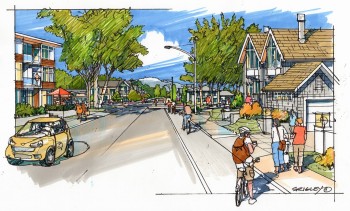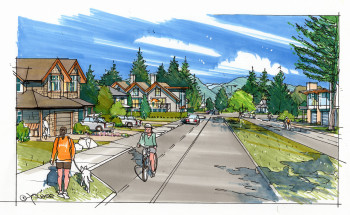District of Squamish to consider policy tools to incentivize low carbon building construction, promote development of neighbourhood nodes and increase transit frequency
Community input is requested via survey on proposed incentive tools
As part of the 2020 Zoning Bylaw Update, the District of Squamish is considering implementation of a set of policies to incentivize and encourage two specific types of development. These types of development would support community goals relating to climate, health, liveability and connectedness, as identified in the Squamish 2040 Official Community Plan and the Community Climate Action Plan, which sets out actions to reduce greenhouse gas emissions in Squamish by 45% from 2010 levels by 2030, and net-zero emissions by 2050. The Low Carbon Incentive and the Smart Growth Neighbourhood Incentive aim to meet important community goals in exchange for opportunities to add density under specific conditions.
The District proposes to incentivize low carbon building construction that would incorporate heating sources derived from low carbon energy sources such as electricity instead of fossil fuels such as natural gas. In combination with the District’s commitment towards increased energy efficient buildings through the BC Energy Step Code Program, the Low Carbon Incentive will effectively move Squamish towards minimizing the energy footprint of its residential development.
 Secondly, the District proposes to incentivize development along the core transit network and neighbourhood nodes in order to encourage the residential density required to increase transit frequency and enable more shops and services to exist within neighbourhoods. This Smart Growth Neighbourhood Incentive will aim to gently add density into pockets of existing neighbourhoods to work towards more complete neighbourhoods that offer residents shops, services and transit in a walkable area.
Secondly, the District proposes to incentivize development along the core transit network and neighbourhood nodes in order to encourage the residential density required to increase transit frequency and enable more shops and services to exist within neighbourhoods. This Smart Growth Neighbourhood Incentive will aim to gently add density into pockets of existing neighbourhoods to work towards more complete neighbourhoods that offer residents shops, services and transit in a walkable area.
These types of incentive programs are often referred to as density bonus systems.
“A liveable, resilient Squamish can balance the needs of citizens with the health of the planet, but we will need to shift our thinking from what is considered standard today, and these policy tools aim to get us closer to that future state,” says District of Squamish Mayor Karen Elliott. “We are in a climate emergency and while it’s tempting to talk about trade offs, in reality, more walkable neighbourhoods, access to transit and safe cycling and walking infrastructure provide critical benefits for the health, wellbeing and human connectivity in our neighbourhoods. We encourage residents to learn more and weigh in on these tools and help us establish sound policy direction that sets us on an aggressive but achievable path.”
The incentive tools are designed to bring about the following benefits:
Benefits for Squamish Residents:
 More attainable housing options in all existing neighbourhoods to support residents through all stages of life;
More attainable housing options in all existing neighbourhoods to support residents through all stages of life; - More frequent transit service on the core network working towards a 15-minute frequency;
- More pedestrian and bike-friendly neighbourhoods;
- More neighbourhood-oriented shops and services so that residents can meet many daily needs within walking distance from home.
Broad Community Benefits:
- Reduced greenhouse gas production by encouraging the use of non-carbon residential energy sources, and increasing transit mode share away from vehicle usage;
- Establishment of an ongoing revenue stream to fund amenity projects such as bike paths, parks or childcare facilities;
- Securing contributions to support affordable housing initiatives;
- Less air pollution by reducing single vehicle trips;
- Responsible asset management – adding residents within the current neighbourhood footprint to help maintain current infrastructure, reducing pressure on property taxes.
How it works:
The Low Carbon Incentive would:
- Reduce the permitted density allowed by one third for buildings that use high carbon energy sources, but allow buildings to achieve full density if they incorporate only low carbon sources such as baseboard heaters, heat pumps and electric hot water tanks.
- Home builders choosing to install a natural gas fireplace or furnace would be required to build a home one third smaller than previously allowed.
The Smart Growth Neighbourhood Incentive would:
- Allow for increased density along the core transit network and neighbourhood nodes. View map.
- Allow for additional housing forms to gently increase density in the forms of duplexes and triplexes, and added floor space in multi-family properties.
- Require a proposed cash amenity contribution of 50% of the increased value achieved through the density bonus.
The District is seeking community feedback on these policy tools prior to discussions at an upcoming Council meeting. Learn more and provide input here.
About the Community Climate Action Plan (CCAP):
The CCAP sets out a vision for Squamish that in 2030, emissions in the District of Squamish will be reduced by at least 45% from 2010 levels, and the community will be on track to achieve net-zero emissions by 2050. This is in line with the Intergovernmental Panel on Climate Change warning that global warming must be limited to 1.5 degrees Celsius. Six Big Moves have been established to guide District actions to align with limiting warming to 1.5°C. Decarbonizing existing buildings and constructing better buildings are two of the Big Moves that address greenhouse gas emissions stemming from, in part, natural gas usage. Natural gas is estimated to account for 25% of greenhouse gas emissions in Squamish. Shifting beyond the car is a third Big Move that aims to address the 53% of community greenhouse gas emissions stemming from mobility fuels such as gasoline and diesel used in transportation.
- - - -
*Above are conceptual future scenarios* for areas along the Core Transit Network or in Neighbourhood nodes. The proposed Smart Growth Neighbourhood Incentive would support duplexes and triplexes in these traditionally single-family neighbourhoods, or slightly larger multi-family developments where these forms are already permitted. The additional residences offer a more diverse range of housing options, while the increased population would support more frequent transit service and support more vibrant neighbourhood nodes that serve residents’ day-to-day needs with shops and services. Amenity contributions from the incentive system could be used to invest in cycling infrastructure while redevelopment could provide funding for sidewalks to improve neighbourhood walkability.
*Concept drawings only to support engagement.
September 29, 2020
Post your comment
Comments
No one has commented on this page yet.
RSS feed for comments on this page | RSS feed for all comments